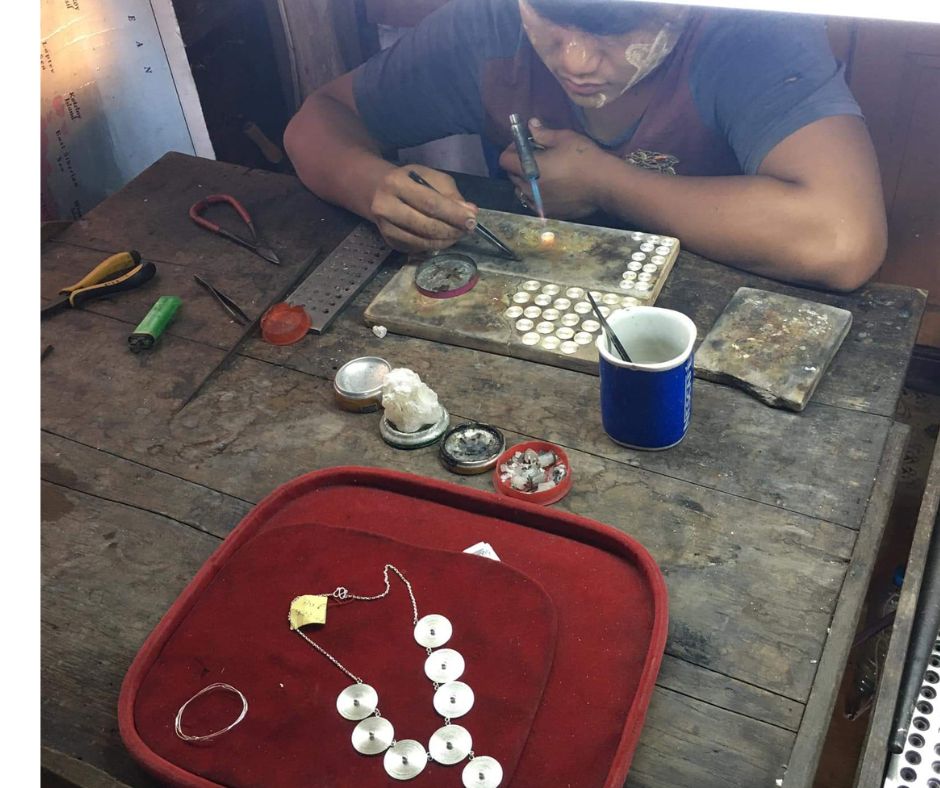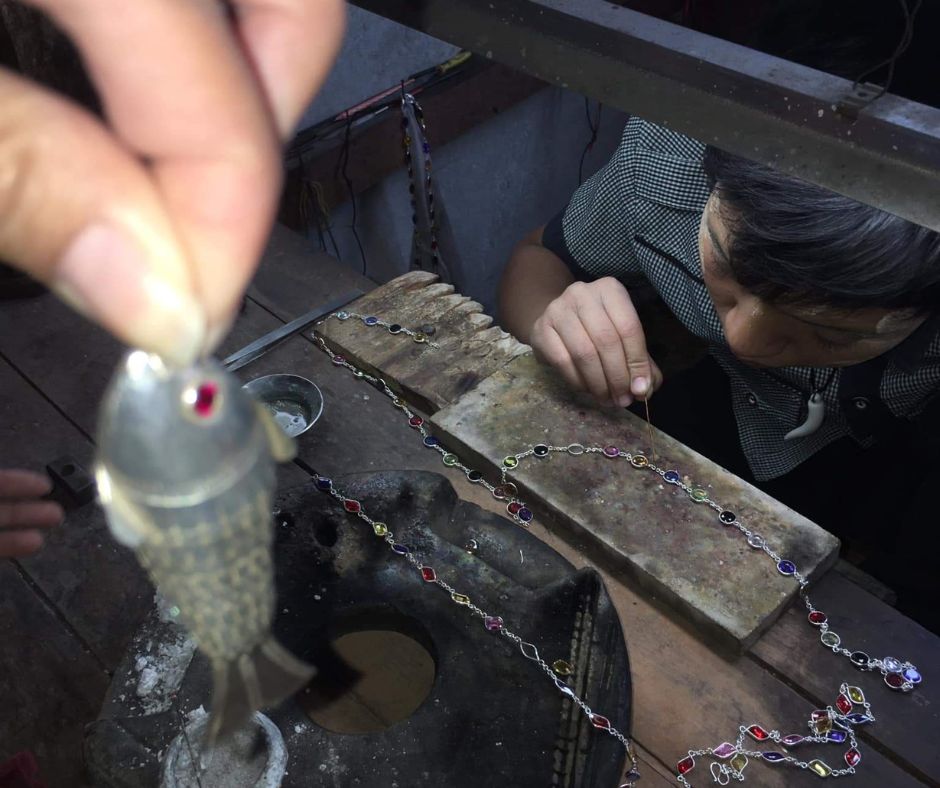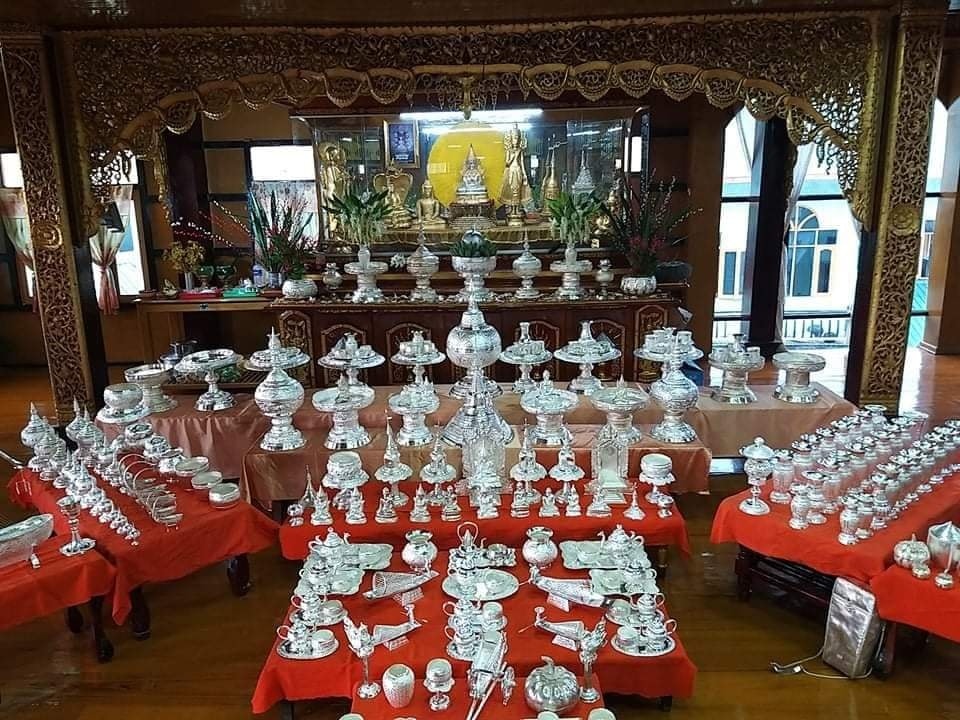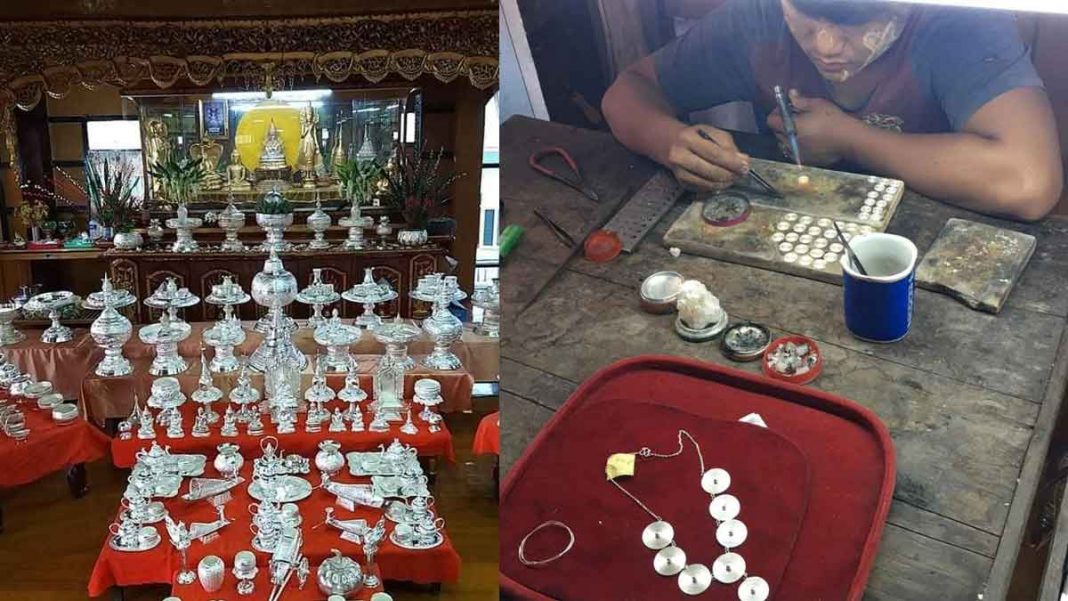The weather is very cloudy and dark, and the occasional rain shower could not stop Ko Myo Aung from cutting the taro stems that grow on the surface of the lake- he patiently cuts those taro stems and places them on his boat.
.
The Inle Lake, located in Nyaung Shwe township, Southern Shan State, was once filled with tourists around the world for its well-known attractions. The Inle region has been quiet because of the Covid-19 pandemic, and it is getting worse one year after the military coup.
“Very few local tourists during the summer this year, and almost no international tourists during the past two years. The businesses that are depending on the international tourists are all ruined. For example, the silversmith business had to quit since Covid-19 pandemic and it has been already two years,” a silversmith, Ko Myo Aung, from He Har village told SHAN.
Inle Lake is situated 2,900 feets above the sea level, and its area is approximately 44.9 square miles. It is a natural lake in the mountainous region and well-known both locally and internationally. The locally made silk, the fabric produced from the lotus fiber grown in the Inle Lake, and the traditionally designed silver products and other souvenirs are famous worldwide.

Before Covid-19 pandemic, the cost of an ounce of silver was only around 12,000 Kyat. The designs that are preferred by the foreign tourists are handcrafted at home, and distributed to the souvenir shops. Since the products are handcrafted, the silversmiths who pay more attention to details got paid more, and on average a professional silversmith earned from 15,000 – 20,000 Kyat daily – Ko Myo Aung explained the business situation before Covid-19 pandemic.
According to the 2014 consensus, 4,528 people – 2,499 males and 2,029 females, are living in the He Har Ywar Ma village, Inlay Lake region. The residents are relying on the silverware businesses, and most of them are silversmiths for generations.
“Since this is a handcrafted business, the more detailed and difficult it is, the more we earn. Silversmithing has been our family business for generations. In the past, it was fine during the low season – we just took a rest and it was temporary. However, it has been two years that I am jobless and I have to do whatever job is available now,” the 40 years old, Ko Myo Aung, told SHAN.
Ko Myo Aung learned how to craft silver from his parents when he was 13 years old, and his son and daughter are now university students at Taunggyi University while his wife is also working on silver crafting. The two could support their children well with their earnings from silver crafting; however, it has been very difficult lately, and they have to grab whatever jobs available – they are very concerned about their future.

“I wake up early in the morning to cut and collect taro stems. I have to get at least 8 kilograms of dried taro stems daily. After cutting and collecting, they are dried at home before selling them. I could earn about 10,000 Kyat daily, and they can cover some expenses,” Ko Myo Aung continued telling his story.
During summer break, their two children would also join them to work in the farm, and they could earn about 20,000 Kyat daily. During the rainy season, their elder parents also helped them peel taro stems in order to dry them. The dried taro stems could be sold for around 10,000 Kyat per kilogram, and they are earning less due to the increase in gasoline price.
“We are not alone who are facing a hard time like this, there are approximately over one hundred silversmiths in our village. We are on the same boat. In the current local market, most of the silver crafting is done using machines. It is not easy for us to change from handcrafting to using a machine. There is no demand for handcrafted products locally, only foreigners prefer them,” Ko Myo Aung continued, explaining the difficulties of the handcrafted silversmiths.
Due to Myanmar Kyat depreciation, the cost of an ounce of silver is around 24,000 Kyat. If an ounce of silver is beautifully handcrafted to the foreigner’s preference, it can be sold from 50 USD up to 200 USD. However, some commissions have to be paid to tourist guides and boatmen – a souvenir shop owner in Inle Lake narrated the story.
Even though some international airlines resume their businesses after Covid-19 pandemic, it is unlikely that foreign tourists will come to Myanmar because of the military coup and the instability situation inside Myanmar. The villages next to Inle Lake, such as La Hel village and Lwe Ma Guu Taung village in Phaikhun township, are among the armed conflict zones – Ko Myo Aung expressed his analysis.
Along with the armed revolution nationwide, young people in Nyaung Shwe township gathered and established Inle People Defense Force (IPDF) in order to participate in the revolution.

In 2019, Myanmar received about 4.36 million foreign tourists, and generated about 2,818.75 million USD as a national income. After the announcement of Covid-19 pandemic, almost all of the travel and tour businesses suspended. In 2020, only 900,000 incoming tourists came to Myanmar, and after the military coup in 2021, the number has decreased to 130,000 according to the ministry of hotel and tourism report.
Starting from 17 April this year, commercial flights are allowed to resume at the Yangon International Airport, and tourist visa holders are permitted to land starting from 20 May. Since 24 May, tourists from 27 countries, totaling 5,561 people have entered Myanmar. On average, 282 flights with 9 airlines are operating daily – announced by the military-backed ministry of hotel and tourism.
However, while the lives of Myanmar civilians are insecure, it is impossible that the tourism sector will be bouncing back to normal. The situation is hopeless until the political situation is stable. Many well-known hotels including those located in the Inle region are on sale – U Thet Win who has been a tourist guide for many years in Southern Shan State provided his analysis.
Due to the termination of tourism businesses in the Inle region, young people in the area are jobless, and most of them end up drinking and taking illicit drugs according to Ko Myo Aung.
“Regardless of the situation, I will not leave the Inle region – we have been drinking this water and living on this land for generations. During this political crisis, I do not want to say “come and visit our country” to tourists. If my children would like to go and work somewhere else, I will not hold them back – it is their decision,” Ko Myo Aung strongly expressed himself to SHAN.
In the past, Inle Lake was filled with tourists riding motorboats visiting the famous pagodas and the handcrafts. Even though the Lake is now occupied with the boats cutting and collecting taro stems, Ko Myo Aung is still hopeful that the place will be full of happy travelers soon.




